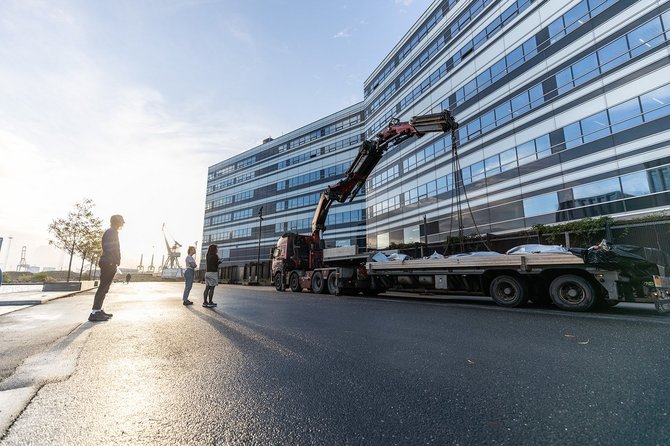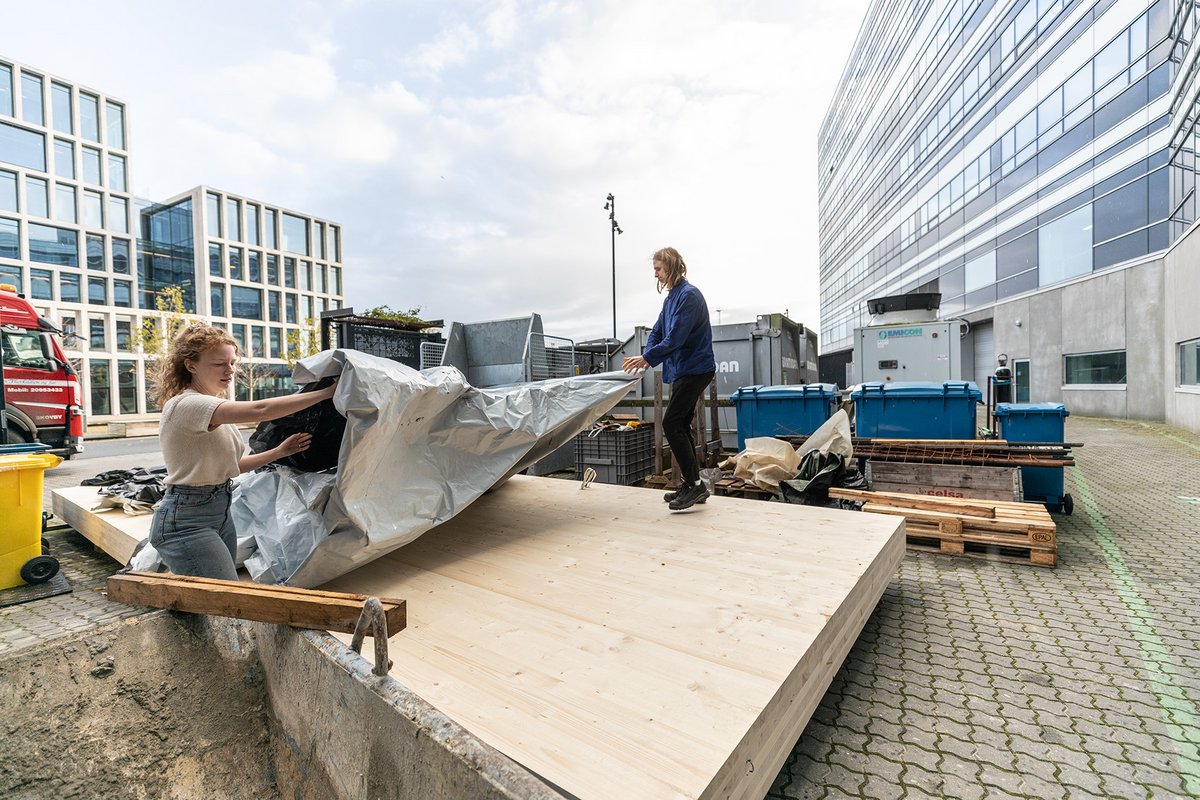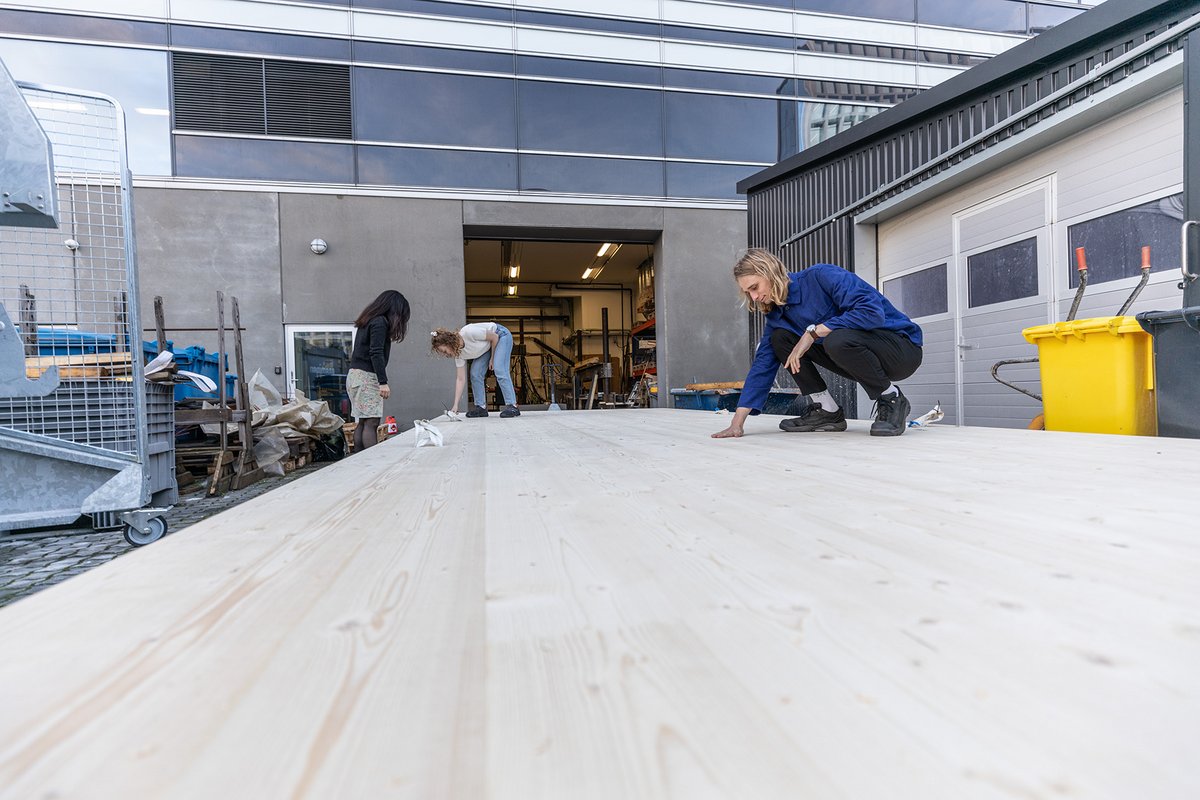
On 7 November, a 6 x 3-metre timber deck was delivered to the laboratory for load-bearing structures at Navitas in Aarhus. The deck can be used as floor separation in buildings.
Thomas Rønberg Thomsen, Anne Askær Bastholm and Sofie Yan Rasmussen are on their seventh semester studying architectural design, and they will be the first to perform experiments on the deck. They have specialised in load-bearing structures, and the new deck is the core of their Bachelor's project.
The timber deck is made of CLT, which stands for cross laminated timber. It consists of thin wooden boards that are glued together to form a solid deck that can be cut at the factory and stacked like LEGO bricks on the construction site. The timber deck weighs two tonnes, while a concrete deck with the same dimensions would weigh approximately five-times more.
"When you come down to it, we’re trying to deal with the problem that we want to build more using timber, but timber has the disadvantage that it is a light and rigid material that is more susceptible to oscillation than concrete. We’re trying to identify some of the comfort problems this can cause by looking at how stiffness in a fixed column joint can influence the comfort of the deck," says Anne Askær Bastholm.
And the oscillations Anne Askær Bastholm mentions can be felt: especially in older flats with timber structures.
"It can feel as if someone is walking right behind you. It's really unpleasant. You can feel it if the deck bends just a fraction of a millimetre when you go walk on it, and in psychological terms it can feel as if it is about to collapse," says Thomas Rønberg Thomsen.

Concrete is the most widely used building material In Denmark. Concrete is made from cement, and cement production alone is estimated to be responsible for approx. five per cent of the world's total anthropogenic carbon emissions. Concrete production also requires sand and gravel, and extracting these is also a major cost in the climate accounts.
On the other hand, wood is a renewable resource, and it takes CO2 out of the atmosphere. If we build with wood, carbon will be stored in the buildings.
Therefore, there are significant carbon savings in replacing carbon-intensive materials such as concrete in load-bearing structures, and this could have a major impact on the future of construction.
"Looking at the objectives set for the construction industry and carbon reductions by 2030, I'm sure that timber will be playing an important role, and I think that a great deal of timber will be used over the next few years," says Bo Pedersen, head of skills in timber construction at MOE Consulting Engineers, who has helped the students set up their Bachelor's project.
The idea behind the project comes from the students' supervisor, Jannick Faurholm Hansen, who is an associate professor at the Department of Civil and Architectural Engineering, and the project has been finalised in collaboration with Bo Pedersen from MOE.
MOE wants to learn more about whether the rigidity they build into a virtual model of timber elements (a so-called FEM model), fits the real world, or whether the models can be made more accurate.

The students have seen MOE’s FEM model, and they have created their own corresponding CLT deck to work with. They will now examine whether the rigidity they build into their model matches the rigidity and comfort they can measure on the real deck. This work could have great value for companies:
"This is something we can really benefit from. Promising results from the experiments will be valuable, as we can then make more accurate calculations," says Bo Pedersen.
Accurate calculations are also important for sustainability.
If a virtual model of the timber deck is just on the brink of comfort requirements, a layer of concrete could be added as a damper. This would make the results more certain, but there is a risk of using more resources than necessary.
"If we replace concrete with timber, and yet end up laying a layer of concrete on top, we’re back to square one. We hope that we’ll be able to increase certainty so we can avoid using an extra layer of concrete," says Thomas Rønberg Thomsen.
The students’ Bachelor's project builds on work with the virtual FEM model and experiments on the CLT deck in the laboratory. The aim of the experiments is to identify the dynamic properties of the deck and to understand how the rigidity affects comfort.
"We need to excite the deck, as the experts say. In other words, we will tickle it a little, as our supervisor says. In practice, we will have to stand under the deck and hit it with broom handles to simulate what’s called Gaussian white noise. We will try to excite the deck with the same energy at all frequencies,” explains Anne Askær Bastholm.
The aim is to find a way to fix the decks together to provide the smallest oscillations and the highest level of comfort.